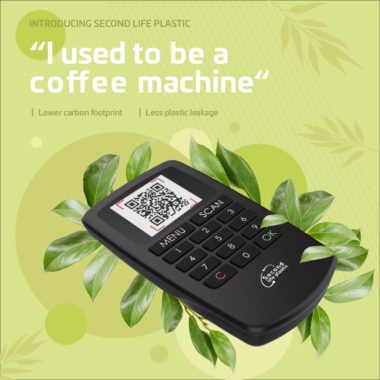The financial services industry, like every other, has a responsibility to look after the environment. Giving a second life to plastic with recycled OTP devices is a great way to reduce their environmental impact.
Let’s take a closer look.
When it all started
In 1907 Belgian-American chemist Leo Baekeland created Bakelite, the first real synthetic, mass-produced plastic made from fossil fuels. His work opened the floodgates to the widespread usage of plastics, the material used for many of the objects in our everyday lives, including credit cards, coffee cups, and phone cases.
Plastic pollution has since become one of the biggest problems facing natural ecosystems across the globe – due to the fact that it takes so long to decompose. Any plastic thrown away or not disposed of properly is therefore at risk of building up, a phenomenon that has led to the creation of a huge plastic garbage vortex in the North Pacific Ocean – now estimated to be three times the size of France.
While it is encouraging to see the continued transition of our economy from a linear model (take, make, use, dispose) to a circular model (make, use, reuse, remake, recycle), there is more the financial services industry can do to be greener.
Making the financial services industry greener goes beyond cards
In our blog post from July 2020, we discussed that one way banks are beginning to transition into a more environmentally friendly offering is by using recycled plastic from the oceans in the creation of credit and debit cards. This will go a long way to helping the industry reduce its plastic use. However, with many other objects in the payments chain also made from plastic, to truly make an impact, there are other opportunities to be more sustainable within banks’ product offerings.
Green One-time password (OTP) devices are a great example of a piece of equipment that the financial services industry can make greener. Looking at the three r’s (reduce, reuse, recycle), cutting back on the production of these devices is not practical. Even if banks are increasingly deploying mobile authentication solutions, many still use physical password generators. These authentication devices can be made from recycled materials – reducing their overall environmental impact.
Nonetheless, for banks to be fully on board with changing their regular plastic OTP devices to those made from recycled plastic, certain conditions must be met.
Considerations and benefits
Firstly, it is key that the functionality of the OTP device does not change. While this may seem obvious, to be a worthwhile business change, the green OTP device must be able to authenticate their customers’ transactions just as seamlessly as before.
Secondly, using recycled plastic must not change the quality of the device and the resulting product must still be able to withstand demanding consumer environments (impacts, scratches, etc.). Using a plastic such as Acrylonitrile Butadiene Styrene (ABS) provides good impact resistance, while still being relatively rigid and light. As a plastic that generally makes up the majority of our household appliances, it’s also widely available.
Thirdly, the benefits of switching to a greener product must be tangible, both in terms of cost savings and brand positioning. Findings from research initiated by Thales and conducted by sustainability consultants Quantis this year discovered, based on the assumption made from one million devices, giving plastic a second life saves more than 50% of total resources used in the creation of the casings for the green OTP devices. This includes 25 tonnes of virgin ABS plastic, and 104 tonnes of CO2 emissions each year (the equivalent of driving 10 times around the earth). This represents a significant reduction in the use of resources and toxic byproducts.
To reassure customers and communicate these benefits, it’s important that banks make it as clear as possible that the product is made with recycled materials. Only with a guarantee that the product is contributing to the circular economy will it be possible to get true engagement for their green offering.
We believe digital banking can be both secure and environmentally friendly, especially when consumers are increasingly looking to spend their money with brands that align with their values. We are here to support the financial services industry in the transition to becoming greener with our OTP devices made from second life plastic which satisfies all these requirements. It is also a significant step towards reducing the environmental impact of authentication devices in the transition towards a full circular economy. You can learn more about our green OTP token offering here.



